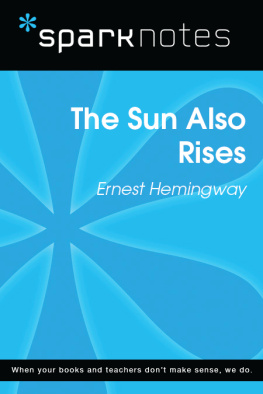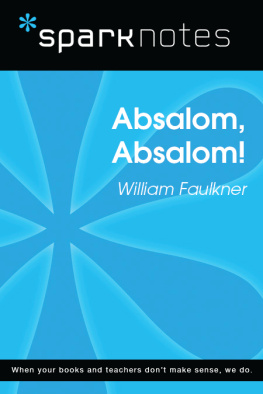The Pre-Civil War Era (18151850)
History SparkNotes
2003, 2007 by Spark Publishing
This Spark Publishing edition 2014 by SparkNotes LLC, an Affiliate of Barnes & Noble
All rights reserved. No part of this publication may be reproduced, stored in a retrieval system, or transmitted in any form or by any means (including electronic, mechanical, photocopying, recording, or otherwise) without prior written permission from the publisher.
Sparknotes is a registered trademark of SparkNotes LLC
Spark Publishing
A Division of Barnes & Noble
120 Fifth Avenue
New York, NY 10011
www.sparknotes.com /
ISBN-13: 978-1-4114-7283-9
Please submit changes or report errors to www.sparknotes.com/.
10 9 8 7 6 5 4 3 2 1
Overview
The preCivil War years ( 1820 1860 , or the antebellum years) were among the most chaotic in American historya time of significant changes that took place as the United States came of age. During these years, the nation was transformed from an underdeveloped nation of farmers and frontiersmen into an urbanized economic powerhouse. As the industrialized North and the agricultural South grew further apart, five major trends dominated American economic, social, and political life during this period.
First, the Market Revolutionthe shift from an agricultural economy to one based on wages and the exchange of goods and servicescompletely changed the northern and western economy between 1820 and 1860 . After Eli Whitney invented the cotton gin and perfected manufacturing with interchangeable parts, the North experienced a manufacturing boom that continued well into the next century. Cyrus McCormicks mechanical mower-reaper also revolutionized grain production in the West. Internal improvements such as the Erie Canal and the Cumberland Road, combined with new modes of transportation such as the steamboat and railroad, allowed goods and crops to flow easily and cheaply between the agricultural West and manufacturing North. The growth of manufacturing also spawned the wage labor system.
Second, American society urbanized drastically during this era. The United States had been a land comprised almost entirely of farmers, but around 1820 , millions of people began to move to the cities. They, along with several million Irish and German immigrants, flooded northern cities to find jobs in the new industrial economy. The advent of the wage labor system played a large role in transforming the social fabric because it gave birth to Americas first middle class. Comprised mostly of white-collar workers and skilled laborers, this growing middle class became the driving force behind a variety of reform movements. Among these were movements to reduce consumption of alcohol, eliminate prostitution, improve prisons and insane asylums, improve education, and ban slavery. Religious revivalism, resulting from the Second Great Awakening, also had a large impact on American life in all parts of the country.
Third, the major political struggles during the antebellum period focused on states rights. Southern states were dominated by states rightersthose who believed that the individual states should have the final say in matters of interpreting the Constitution. Inspired by the old Democratic-Republicans, John C. Calhoun argued in his South Carolina Exposition and Protest essay that the states had the right to nullify laws that they deemed unconstitutional because the states themselves had created the Constitution. Others, such as President Andrew Jackson and Chief Justice John Marshall, believed that the federal government had authority over the states. The debate came to a head in the Nullification Crisis of 1832 1833 , which nearly touched off a civil war.
Fourth, and closely tied to the states rights issue, was the debate over slaverythe most divisive issue the nation had yet faced. Between 1820 and 1860 , more and more northerners came to realize the horrors and injustices of slavery, while southerners grew increasingly reliant upon it to support their cotton-based economy. Northerners did not necessarily want social and political equality for blacks; they sought merely their emancipation. The debate in politics centered primarily on the westward expansion of slavery, which southern elites saw as vital to the survival of their aristocratic social and economic order. Others vehemently opposed the expansion of slavery outside the South. The debate was critical in the Missouri crisis, the annexation of Texas, and after the Mexican War.
Finally, the issue of westward expansion itself had a profound effect on American politics and society during the antebellum years. In the wake of the War of 1812 , many nationalistic Americans believed that God intended for them to spread democracy and Protestantism across the entire continent. This idea of manifest destiny spurred over a million Americans to sell their homes in the East and set out on the treacherous Oregon, Mormon, Santa Fe, and California Trails. Policymakers capitalized on public sentiment to acquire Florida and Oregon and declared war on Mexico in 1846 to seize Texas, California, and everything in between.
Ultimately, these trends irreconcilably split the North from the South. The Market Revolution, wage labor, improved transportation, social reforms, and growing middle class of the North all clashed with the deep-seated, almost feudal social hierarchies of the South. Each successive debate on slavery and westward expansion drove the regions further apart until finally, in the 1850 s, the North and the South were two wildly different places, culturally, socially, and economically.
Summary of Events
The Era of Good Feelings
Americans came out of the War of 1812 with a new sense of national pride. Though the war was largely a stalemate, the astonishing American victory at the Battle of New Orleans made the nation feel as though it had won a second war for independence.
The election of James Monroe to the presidency in 1816 marked the beginning of a period of one-party rule, often termed the Era of Good Feelings. The new sense of pride broke down old political barriers and united Americans behind the common goal of improving the nation. In fact, the nation was so unified that Monroe ran uncontested for a second term in 1820 .
The American System
Politicians rallied behind Speaker of the House Henry Clay and his American System to improve the national infrastructure. Clay wanted to make internal improvements to national transportation to link the agricultural West with the industrial North. Dozens of new canals and roads were built at the governments expense, such as the Erie Canal and the Cumberland Road. Clay also pushed the Tariff of 1816 through Congress to protect new manufacturers by raising the tax on goods produced abroad. Finally, Clay hoped to bolster the national economy by establishing a new Bank of the United States.
Landmark Decisions and Doctrines
The Supreme Court, under Chief Justice John Marshall, made several landmark decisions during this period, including McCulloch v. Maryland, Dartmouth College v. Woodward, Cohens v. Virginia, Gibbons v. Ogden, and Fletcher v. Peck. An ardent Federalist, Marshall issued decisions that strengthened the Court and the federal government relative to the states.
Meanwhile, President Monroe and Secretary of State John Quincy Adams issued the Monroe Doctrine in 1823 , warning European powers to stay out of affairs in the western hemisphere. Like the early Supreme Court decisions, the Monroe Doctrine has had a large and lasting influence on American policy.



















